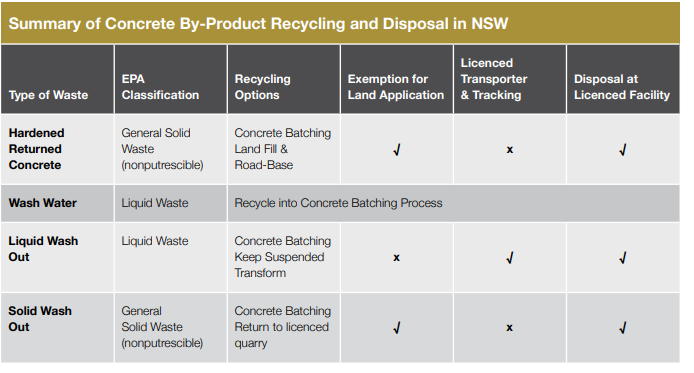The final step is cleaning up the site. The process for cleaning up the site is:
Step 6: Cleaning up
- Cleaning up the site
- Checking, maintaining, and storing tools and equipment
By now, you will already have a good understanding of the processes involved in site clean-up. The process is fairly consistent, however, with concrete, there are additional environmental considerations. It is also important to be aware, some disposals require licenses and appropriate disposal sites.
When disposing of concrete there are four main products which need to be carefully disposed of, these include:
- hardened returned concrete
- concrete wash water
- liquid wash out/ slurry
- solid wash out.
Let us take a look at how best to dispose of each of these products.
Hardened returned concrete
This type of waste does not need a licensed transporter to remove the waste, though it does need to be tracked. When it is transported, it needs to go to a licenced facility where it can be appropriately disposed. You can look up relevant facilities that will support this disposal if you are unsure of where to locate a service. You can find the link in your additional resources at the end of this module. 2
Concrete wash water
Concrete wash water can be stored on site at a concrete batch plant. It is stored in settling ponds and tanks where it is recycled into the concrete batching system. 2
Liquid wash water/ slurry
Liquid wash water/ slurry has a high PH making it high in alkaline with high suspended solid content. 2
The following image from Cement, Concrete and Aggregates Australia advises on the measures to be taken when disposing of concrete. The concrete wash water can be stored in a licensed facility with access to a settling pond, where the water can be pumped out and recycled leaving behind the sediments and high alkaline material.2
Solid wash out
Solid wash out has the consistency of clay and is returned to concrete once it has been washed and dried out. When disposing of solid wash out, it does not need a licensed transporter, nor does it need to be track. It does however, require disposal in a relevant licensed facility. 2
The following image from CC

In addition to the appropriate disposal of concrete waste, when cleaning up the worksite, keep in mind that you must:
- Follow the site’s procedures for safe environmental clea up. Where possible, recycle any concrete materials not in use.
- Follow the site’s procedure to ensure that the clean up process does not put yourself or others at risk of injury or harm
- Always consider the principles of reduce, reuse and recycle
- Avoid contaminating stormwater when cleaning tools, equipment, materials and the work area
- Clean concrete from all tools and equipment
- Follow manufacturer instructions for cleaning and servicing tools and equipment
- Check tools and equipment for defects and/or damage before storing them
- Report any faults in tools and equipment and immediately remove them from service
- Check and clean PPE
- Clean and dry all tools and equipment before storing them
- Store tools and equipment securely and according to manufacturer specifications and instructions
- Store tools and equipment according to workplace specifications

